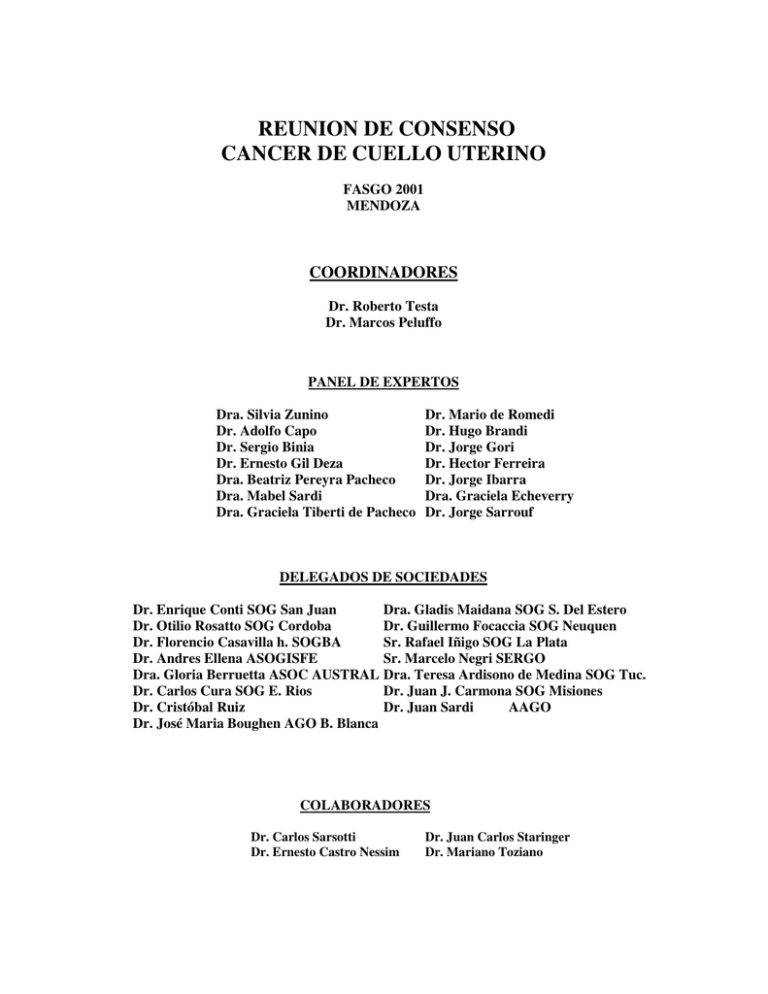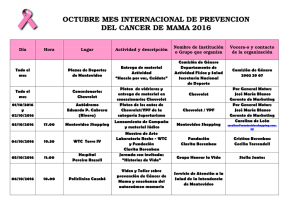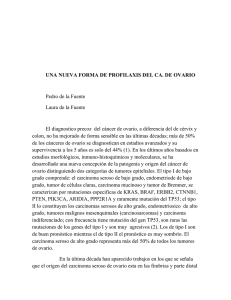reunion de consenso cancer de cuello uterino
Anuncio

REUNION DE CONSENSO CANCER DE CUELLO UTERINO FASGO 2001 MENDOZA COORDINADORES Dr. Roberto Testa Dr. Marcos Peluffo PANEL DE EXPERTOS Dra. Silvia Zunino Dr. Adolfo Capo Dr. Sergio Binia Dr. Ernesto Gil Deza Dra. Beatriz Pereyra Pacheco Dra. Mabel Sardi Dra. Graciela Tiberti de Pacheco Dr. Mario de Romedi Dr. Hugo Brandi Dr. Jorge Gori Dr. Hector Ferreira Dr. Jorge Ibarra Dra. Graciela Echeverry Dr. Jorge Sarrouf DELEGADOS DE SOCIEDADES Dr. Enrique Conti SOG San Juan Dra. Gladis Maidana SOG S. Del Estero Dr. Otilio Rosatto SOG Cordoba Dr. Guillermo Focaccia SOG Neuquen Dr. Florencio Casavilla h. SOGBA Sr. Rafael Iñigo SOG La Plata Dr. Andres Ellena ASOGISFE Sr. Marcelo Negri SERGO Dra. Gloria Berruetta ASOC AUSTRAL Dra. Teresa Ardisono de Medina SOG Tuc. Dr. Carlos Cura SOG E. Rios Dr. Juan J. Carmona SOG Misiones Dr. Cristóbal Ruiz Dr. Juan Sardi AAGO Dr. José Maria Boughen AGO B. Blanca COLABORADORES Dr. Carlos Sarsotti Dr. Ernesto Castro Nessim Dr. Juan Carlos Staringer Dr. Mariano Toziano CAPÍTULO 1. DIAGNÓSTICO Y ESTADIFICACIÓN Estadío Ia: Obligatorio: conización Con estudio histopatológico de acuerdo a estándares internacionales Estadío IB1: Examen vaginal y rectal (recomendable bajo anestesia) Medición del tamaño tumoral Evaluación de la vía urinaria: Urograma excretor o TAC con contraste E.V. o Pielografía por RMN Estadío IB2 o mayor estadío: Examen vaginal y rectal (recomendable bajo anestesia) Medición del tamaño tumoral Rx. de tórax frente y perfil Evaluación de la vía urinaria: Urograma excretor o TAC con contraste E.V. o Pielografía por RMN Cistoscopia Rectoscopia Todos (Cat. 1)* CAPÍTULO 2. TRATAMIENTOS POR ESTADIOS 2.1 RECOMENDADOS. 2.1.1 Estadio IA1 Histerectomía extrafascial Si el cono es suficiente, en una mujer joven con deseos de fertilidad, puede considerarse terapéutico (Cat. 1)* 2.1.2 Estadio IA2, IB1 Quirúrgico Primario: Colpoanexohisterectomía total ampliada por vía abdominal o vaginal con linfadenectomía pelviana. (Operación de Wertheim Meigs, Piver III o Schauta con linfadenectomía) (Cat 1)* Conducta intraoperatoria: la presencia macroscópica de ganglios pelvianos sospechosos, confirmados anatomopatológicamente, no invalidaría continuar con la cirugía. La presencia de ganglios lumboaórticos macroscópicamente sospechosos, confirmados anatomopatológicamente, invalidaría la cirugía (Cat 2)* Conservación de Ovarios: en una mujer joven, carcinoma escamoso, ovario sano, es posible su conservación. Se recomienda fijarlo en situación extra pelviana. (Cat 1)* Radiante Primario: Braquiterapia + Radioterapia externa pelviana 2.1.3 . Estadíos IA2 – IB1 y IIA con tumor hasta 2cm Posibilidad de realización de cirugía menos radical. Colpoanexohisterectomía total ampliada modificada por vía abdominal tipo Piver II o su equivalente por vía vaginal con linfadenectomía pelviana ( Massi clase II ) (Cat 2)* 2.1.4 Estadío IB2 - IIA A- Quimioradioterapia concurrente con Platino (Radioterapia externa pelviana + Braquiterapia) (Cat 2)* Frente a la presencia de tumor residual en el cuello, luego de un lapso prudencial de terminado el tratamiento ( 60-90 dias ), se sugiere la Anexohisterectomia extrafascial B- Tratamiento quirúrgico primario con la operación de W.M. (Cat 3)* El estadio IIA con tumor menor de 4 cm. Puede ser tratado con cirugía (Cat 1)* Investigación: La evidencia actual sugiere continuar con la investigación clínica del uso de la Qt neoadyuvante basada en platino seguida de cirugía en éste grupo de pacientes (Cat.2)* Histerectomía adyuvante luego de quimioradioterapia concurrente con platino Recordamos que todo protocolo de investigación clínica deberá ser realizado bajo estrictas normas y en centros médicos avalados para dicha investigación 2.2 NUEVAS TENDENCIAS EN CASOS SELECCIONADOS 2.2.1 Estadios IA2 – IB1 y IIA con tumor hasta 2cm A- Traquelectomía radical En pacientes: a) jóvenes b) con deseos de fertilidad: c) tumores exofíticos d) sin patología concurrente e) adecuadamente informada que no es estándar y con su consentimiento g) ganglios anatomopatológicamente (-) por linfadenectomía h) biopsia por congelación negativa del margen (Cat. 2)* B- Si el cono suficiente en estadio IA2 En pacientes: a) jóvenes b) con deseos de fertilidad: c) sin conocidas alteraciones de fertilidad en la pareja d) sin patología concurrente e) adecuadamente informada y con su consentimiento y f) ganglios anatomopatológicamente (-) por linfadenectomia (Cat 3)* 2.2.2 Conducta postquirúrgica estadíos Ia2 – Ib1 – IIa A- Sin factores de riesgo anátomo-patológicos (ganglios, parametrios y sección de corte vaginal negativos) Observación B- Si ganglios positivos o sección de corte parametral positivo. Radioterapia externa pelviana + / - Braquiterapia B- Si margen vaginal positivo. Radioterapia externa pelviana + Braquiterapia Nuevas tendencias Quimioradioterapia concurrente con Platino (Radioterapia externa pelviana + Braquiterapia) en lugar de radioterapia sola (Cat. 2 )* En pacientes tratados con cirugía radical, cuya pieza muestre tamaño tumoral mayor de 4cm , se debe agregar radioterapia pelviana. Y eventual braquiterapia (Cat 1)* 2.3 ESTADIO IIB – IIIA – IIIB – IVA. Quimioradioterapia concurrente con Platino (Radioterapia externa pelviana + Braquiterapia) Valorar la posibilidad de: Implantes de braquiterapia parametriales Irradiación lumboaórtica En aquellos casos de estadío IVA sin compromiso parametrial ni ganglionar se sugiere la excenteración pélvica preferentemente con reservorios continentes (Cat 1)* 2.4 ENFERMEDAD RECURRENTE 2.4.1 Evaluación: Dependerá de la modalidad de tratamiento previo A- Si ha recibido radioterapia previamente Examen vaginal y rectal bajo anestesia Si del examen surge la posibilidad de rescate quirúrgico con intento curativo: Rx. de tórax frente y perfil. TC de abdomen y pelvis con contraste oral y endovenoso o UroRMN Cistoscopia Rectoscopia Si del examen surge la imposibilidad quirúrgica Se solicitarán aquellos estudios útiles para definir la conducta terapéutica B- Si no ha recibido Radioterapia previamente Se solicitarán aquellos estudios útiles para la terapéutica 2.4.2 Tratamiento A- Recidiva Pélvica 1- Sin tratamiento radiante previo: Quimioradioterapia concurrente con Platino (Radioterapia externa pelviana + / - Braquiterapia) 2- Con tratamiento radiante previo: Enfermedad central: Exploración quirúrgica (sugerida por cirugía translaparoscópica o retroperitoneal por minilaparotomia) Ganglios Positivos o enf. peritoneal: indicar paliación Negativa: tratamiento de rescate con intento curativo a) Excenteración pélvica b) Menores de 2cm y sin compromisos de las fascias vesico-recto vaginal, evaluar la posibilidad de Colpoanexohisterectomía total ampliada por via abdominal (Operación de Wertheim o Piver III ) si no se ha realizado. Enfermedad lateral: Tratamiento paliativo B- Recidiva Extrapélvica 1-. Única: Considerar resección con finalidad diagnóstica y terapéutica 2- Múltiples: Tratamiento paliativo 2.5 CARCINOMA DE CUELLO OCULTO Hallado luego de histerectomía total simple 2.5.1 Margen Positivo: Quimioradioterapia concurrente con Platino (Radioterapia externa pelviana + Braquiterapia) 2.5.2 Margen Negativo: A- Estadío IA2 Evaluación retroperitoneal (de ser posible por Laparoscopia) Negativa: Control Positiva: Quimioradioterapia concurrente con Platino (Radioterapia externa pelviana + Braquiterapia) B- Estadío IB1 o mayor Quimioradioterapia concurrente con Platino (Radioterapia externa pelviana + Braquiterapia) (Cat. 1)* METODOLOGIA EN EL DESARROLLO DEL CONSENSO 1) Los colaboradores elaboraron en esquema de evaluación y tratamiento 2) Este fue elevado a los representantes de las distintas especialidades para su evaluación y envío de sugerencias 3) El esquema y las sugerencias fueron enviados a los expertos invitados para su estudio 4) Se realizaron tres reuniones entre los coordinadores, los expertos y los colaboradores para desarrollar un esquema final para ser presentado en la reunión abierta durante el congreso de FASGO 5) Reunión abierta: se presentó en forma oral el proyecto elaborado a todos los presentes durante el transcurso del XXXVII Encuentro Nacional Anual FASGO 2001. Cada punto fue sometido a discusión y finalmente al voto de los expertos y los delegados. Cada punto recibió una categorización acorde al nivel de consenso CATEGORÍAS DEL CONSENSO (*) Categoría 1: El consenso es uniforme entre los especialistas, basado en alto nivel de evidencia que la recomendación es apropiada Categoría 2: El consenso es uniforme entre los especialistas, basado en bajo nivel de evidencia y en la experiencia clínica que la recomendación es apropiada Categoría 3: El consenso no es uniforme entre los especialistas, basado en bajo nivel de evidencia y en la experiencia clínica que la recomendación es apropiada. A pesar de lo anterior no existe importante desacuerdo. Categoría 4: No existe acuerdo entre los especialistas que la recomendación sea apropiada BIBLIOGRAFÍA 1- Averette HE, Nguyen HN, et al. Radical hysterectomy for invasive cervical cancer: a 25-year prospective experience with the Miami technique. Cancer 1993, 71: 1422 2- Barton DP, Butler MS at el. Radical hysterectomy for early stage cervical cancer and resulting morbidity. Gynecol Oncol 2001, 82: 410 3- Benedet JL, Turko M, et al. Radical Hysterectomy in the treatment of cervical cancer. Am. J. Obstet Gynecol 1980, 137: 254 4- Benedet J., Odicino F, et al: Carcinoma of the cervix uteri. Annual Report on the Results of Treatment in Gynecological Cancer. J. Epidemiol Biostat 1998, 3: 5-34 5- Burghardt E, Holzer E. Diagnosis and treatment of microinvasive carcinoma of the cervix uteri. Obstet Gynecol 1977, 49:641 6- Burghardt Em Girardi F, et al. Micro invasive carcinoma of the uterine cervix. (FIGO stage IA) Cancer 1991, 67: 1037 7- Burghardt E, Baltzer J, et al. Results of surgical treatment of 1028 cervical cancers studied with volumetry. Cancer 1992, 70: 648 8- Childers J., Hatch K. et al. The role of laparoscopic lymphadenectomy in the management of cervical carcinoma. Gynecol Oncol. 47: 38-43 (1992) 9- Cosin J., Fowler J. et al. Pretreatment surgical staging of patients with cervical carcinoma. The case for lymph node debulking. Cancer 82 (11) 2241-2248 (1998) 10- Covens A, Rosen B, et al. Changes in demographics and preoperative care of stage IA2-IB1 cervical cancer over the past 16years. Gynecol Oncol 2001, 81:133 11- Covens A, Shaw P, et al .Is radical trachelectomy a safe alternative to radical hysterectomy for patients with stage IA-B carcinoma of the cervix. Cancer 1999, 86: 2273 12- Creasman WT. New gynecologic cancer staging. Gynecol Oncol 58:157-158 (1995) 13- Dàrgent D. Retroperitoneal lymphadenectomy. In Laparoscopic Surgery in Gynecologic Oncology. Ch. 5. Blackwell Science. 1999. London. U.K. 14- Dargent D, Mathevet P. Schauta's vaginal hysterectomy combined with laparoscopic lymphadenectomy. Baillieres Clin Obstet Gynaecol.; 9 Dec.(4):691-705. (1995) 15- Dargent D, Brun JL, et al. Pregnancies following radical trachelectomy for invasive cervical cancer. Gynecol Oncol 1994, 52:105 16- Dargent D. Salvat J Envahissement ganglionnaire pelvien: place de la pelviscopie retroperitoneale (1989) Mac Graw-Hill. Paris. Francia. 17- Delgado G, Bundy B, et al. Prospective surgical-pathological study of disease free interval in patients with stage IB squamous cell carcinoma of the cervix.: A Gynecologic Oncology Group study. Gynecol Oncol 1990, 38: 352 18- Downeey, G.O., Potish R.A. et al. Pretreatment surgical staging in cervical carcinoma: Therapeutic efficacy of pelvic lymph node resection. Am J. Obstet Gynecol 160, 1055-1061 (1989) 19- Elliot P, Coppelson M. et al. Early invasive Carcinoma of the cervix. A clinicopathologic study of 476 cases. Int J. Gynecol Cancer 2000, 10: 42 20- Estape RE, Angioli R, et al. Close vaginal margins as a prognostic factor after radical hysterectomy. Gynecol Oncol. 1998, 68: 229 21- FIGO Cancer Committee. Staging Announcement. Gynecol Oncol 1986, 25: 383 22- Fioricca JV, Roberts WS, et al. Morbidity and survival patterns in patients after radical hysterectomy and postoperative adjuvant pelvic radiotherapy. Gynecol Oncol 1990, 36: 343 23- Gentili C, Calcinati A, et al. Microinvasive carcinoma of the uterine cervix. Risk factors and therapeutic options. Minerva Ginecol. 2000, 52: 83 24- Guttman R. Significance of postoperative irradiation in carcinoma of the cervix. A ten-year survey. Am. J. Roentgenol Ther Nucl Med. 1970, 108: 102 25- Hacker NE. Clinical and operative staging of cervical cancer. Bailleres Clin Obstet Gynecol 1988, 2: 747 26- Hacker NF, Wain GV, et al. Resection of bulky positive lymph nodes in patients with cervical cancer. Int J. Gynecol Cancer 1995, 5:250 27- Hatch K. Hallum A. The role of laparoscopy in gynecologic oncology. Cancer 76:2113-2116 (1995) 28- Heller P., MalfetanoJ. et al. Clinical-pathologic study of stage IIB, III and IVA carcinoma of the cervix: Extended diagnostic evaluation for para-aortic node metastasis- A gynecologic Oncology Group Study. Gynecol Oncol 38: 425-430 (1990) 29- Hopkins MP, Peters WA, et al: Invasive cervical cancer treated initially by standard hysterectomy. Gynecol Oncol 1990, 36: 7 30- Inohue T, Chihara T, et al. The prognostic significance or the size of the largest nodes in metastatic carcinoma from the uterine cervix. Gynecol Oncol 1984, 19: 187 31- Kinney WK, Alvarez RD, et al. Value of adjuvant whole pelvic irradiation after Wertheim hysterectomy for early stage squamous carcinoma of the cervix with pelvic nodal metastases: a matched control study. Gynecol Oncol 1989, 34: 258 32- Kim SH., Kim Sc. et al. Uterine cervical carcinoma: Evaluation of pelvic lymph node metastasis with MR Imaging. Radiology 190: 807-811 (1994) 33- Kim PY, Bradley J. et al Cervical cancer with paraaortic metastases: Significance of residual paraaortic disease after surgical staging. Gynecologic Oncology 69, 243-247 (1998) 34- Kinney WK, Egorshin EV, et al. Long-term survival and sequel after surgical management of invasive cervical carcinoma diagnosed at the time of simple hysterectomy. Gynecol Oncol 1992, 44: 24 35- Kolstad P. Follow up study of 232 patients with stage Ia1 and 411 patients with stage Ia2 squamous cell carcinoma of the cervix (microinvasive carcinoma) Gynecol Oncol 1989, 32:265 36- Krebs HB, Helmkamp BF, et al. Recurrent cancer of the cervix following radical hysterectomy and pelvic node dissection. Obstet Gynecol 1982, 59: 422 37- Landoni F, Maneo A, et al. Class II versus class III radical hysterectomy in stage IBIIA cervical cancer: a prospective randomized study. Gynecol Oncol 2001, 80:2 38- Landoni F, Maneo A, et al. Randomized study of radical surgery versus radiotherapy for stage IB IIA cervical cancer. Lancet 1997, 350:535 39- Larson DM, Coppeland LJ, et al. Recurrent cervical carcinoma after radical hysterectomy. Gynecol Oncol 1998, 30: 381 40- Lecuru F, Nejk K et al. Microinvasive carcinoma uterine cervix. Which approach in 1998. Bull Cancer 1998, 85: 319 41- Lécuru F.; Taurelle R. Transperitoneal laparoscopic pelvic lymphadenectomy for gynecologic malignancies (I). Technique and results. Surg. Endosc 12:1-6 (1998) 42- Lécuru F.; R. Taurelle. Transperitoneal laparoscopic pelvic lymphadenectomy for gynecologic malignancies (II). Technique and results. Surg. Endosc 12:97-100 (1998) 43- Loke KJ. Early squamous cell carcinoma of the cervix. Gynecol Oncol 1978, 6: 10 44- Magrina JF, Goodrich MA, et al. Modified radical hysterectomy in the treatment of early squamous cervical cancer. Gynecol Oncol 1999, 72: 183 45- Massi G, Savino L, et al. Three clases of radical vaginal hysterectomy for treatment of endometrial and cervical cancer. Am. J. Obstet.Gynecol. 1996, 175: 1576 46- Mithcell PA, Waggoner S, et al. Cervical cancer in the elderly treated with radiation therapy. Gynecol Oncol 1998, 71: 291 47- Montana GS, Fopwler WC, et al. Analysis of results of radiation therapy for stage IB carcinoma of the cervix. Cancer 1987, 60: 2195 48- Morris M, Eifel P, et al. Pelvic radiation with concurrent chemotherapy compared with pelvic and paraaortic radiation for high-risk cervical cancer. N Engl J. Med 1999, 340: 1137 49- Morrow CP. Is pelvic radiation beneficial in the postoperative management of stage IB squamous cell carcinoma of the cervix with pelvic node metastasis treated by radical hysterectomy and pelvic lymphadenectomy? Gynecol Oncol 1980, 10: 105 50- Nagarsheth NP, Maxwell Gl, et al. Bilateral pelvic lymph node metastasis in a case of FIGO stage IA1 adenocarcinoma of the cervix. Gynecol Oncol 2000, 77: 467 51- Ostor AG. Pandora´s box or Ariadne´s thread? Definition and prognosis significance or microinvasion in the uterine cervix: squamous lesions. In Pathology annual. Melbourne 1995:103-136 52- Ostor AG. Studies on 200 cases of early squamous cell carcinoma of the cervix. Int J. Gynecol Pathol. 1993, 12: 193 53- Ostor AG. Early invasive adenocarcinoma of the uterine cervix. Int. J. Gynecol Pathol. 2000, 19: 29 54- Park RC, Thigpen JT. Chemotherapy in advanced and recurrent cervical cancer: a review. Cancer 1993, 71: 1446 55- Perez CA, Camel HM, et al. Randomized study of preoperative radiation and surgery or irradiation alone in the treatment of stage IB and IIA carcinoma of the cervix: A final report. Gynecol Oncol 1987, 27: 129 56- Peters WA, Liu PY, et al. Cisplatin and 5FU plus radiation therapy are superior to radiation therapy as adjunctive in high risk early stage carcinoma of the cervix after radical hysterectomy and pelvic lymphadenectomy: report of a phase III intergroup study. J. Clin Oncol 2000 18: 450 57- Piver M, Rutledge F, et al. Five classes of extended hysterectomy for women with cervical cancer. Obstet Gynecol 1974, 44: 265 58- Plante M, Roy M. New approaches in the surgical management of early stage cervical cancer. Curr Opin Obstet Gynecol. 2001 13: 41 59- Possover M, Krause N. Laparoscopic assistance for extended radicality of radical vaginal hysterectomy: description of a technique. Gynecol Oncol. 70: 94-9 (1998 ) 60- Potish, R. A.; Twiggs, L.B., et al Therapeutic implications of the natural history of advanced cervical cancer as defined by pretreatment surgical staging. Cancer 56, 956960 (1985) 61- Potish RA, Downey GO, et al. The role of surgical debulking in cancer of the uterine cervix. Int. J. Radiat Oncol Biol Phys 1989, 17: 979 62- Potter ME, Alvarez RD, et al.Early invasive cervical cancer with pelvic lymph node involvement: To complete or not to complete radical hysterectomy? Gynecol Oncol 37:78-81 (1990) 63- Querleu D. Leblanc E. Castelain B. et al Laparoscopic pelvic lymphadenectomy. Am J. Obstet Gynecol 164:579-581 (1991) 64- Rodriguez M, Guimares O et al. Radical abdominal trachelectomy and pelvic lymphadenectomy with uterine conservation and subsequent pregnancy in the treatment of early invasive cervical cancer. Am J. Obstet Gynecol 2001, 185: 370 65- Roman LD, Felix JC, at al. Risk of residual invasive disease in women with microinvasive squamous cancer in a conization specimen. Obstet Gynecol 1997, 90:759 66- Rose PG, Berkowitz RS. Advances in the management of cervical cancer.JRM 2000, 45: 971 67- Rose PG. Type II radical hysterectomy: Evaluating its role in cervical cancer. Gynecol Oncol 2001, 80: 1 68- Rotman M, Choi K, et al. Prophylactic irradiation of the para aortic lymph node chain in stage IIB and bulky stage IB carcinoma of the cervix: initial treatment and results of RTOG 7920. Int J Radiat Oncol Biol Phys 1990, 19: 513 69- Roy M, PlanteM. Pregnancies after radical vaginal trachelectomy for early stage cervical cancer. Am. J. Obstet Gynecol. 1998, 179: 1491 70- Roy M, Plante M. Radical vaginal trachelectomy for invasive cervical cancer. J. Gynecol Obstet Biol Reprod. 2000, 29: 279 71- Roy M, Plante M. et al. Vaginal radical hysterectomy versus abdominal radical hysterectomy in the treatment of early-stage cervical cancer. Gynecol Oncol. 62 Sep (3): 336-9. (1996) 72- Rubin SC, Brookland R, et al. Paraaortic nodal metastases in early cervical carcinoma: long term survival following extended radiotherapy. Gynecol Oncol 1984, 18:213 73- Rutledge FS, Carey MS, et al. Conservative surgery for recurrent or persistent carcinoma of the cervix following irradiation: is exenteration always necessary? Gynecol Oncol 1994, 52: 353 74- Sardi JC, Sananes C, et al. Results of a prospective randomized trial with neoadjuvant chemotherapy in stage IB, bulky squamous carcinoma of the cervix. Gynecol Oncol 1993, 49: 156 75- Sartori E, La face B, et al. Pattern of failure in stage IB-IIA cervical cancer after radical hysterectomy. Int J Gynecol Cancer 1995, 5: 15 76- Schneider A, Possover M. et al. Laparoscopy-assisted radical vaginal hysterectomy modified according to Schauta-Stoeckel. Obstet Gynecol. 88(6):1057-60.(1996) 77- Sedlis A, Bundy BN, at al. A randomized trial of pelvic radiation therapy versus no further therapy in selected patients with stage IB carcinoma or the cervix after radical hysterectomy and pelvic lymphadenectomy: A gynecologic Oncology Group study. Gynecol Oncol 1999: 73: 177 78- Sevin BU. Management of microinvasive cervical. Semin Surg Oncol 1999, 16: 228 79- Sheperd JH, Mould T et al. Radical trachelectomy in early stage carcinoma of the cervix: Outcome as judged by recurrence rate and fertility rates 80- Sheperd JH, Crawford R, et al. Radical trachelectomy: a way to preserve fertility in the treatment of early cervical cancer. 81- Singleton HM, Bell MC, et al. Is there really a difference in survival of women with squamous cell carcinoma, adenocarcinoma and adenosquamous cell carcinoma of the cervix? Cancer 1995, 76: 1948 82- Smith JR, Boyle DC, et al. Abdominal radical trachelectomy: a new surgical technique for the conservative management of cervical carcinoma. Br. J. Obstet Gynecol. 1997, 104: 1196 83- Subak LL. Hricak H Cervical carcinoma: computed tomography and magnetic resonance imaging for preoperative. Obstet Gynecol 86:43-50 (1995) 84- Takamura A, Mizoe J, et al. Is postoperative radiotherapy beneficial in the management of stage I-II squamous cell carcinoma of the uterine cervix with negative nodes and positive parametrial involvement? A retrospective review or 70 patients. Asia Oceania J. Obstet Gynecol 1993, 19: 145 85- Terada K, Morley GW. Radical hysterectomy as surgical salvage therapy for gynecological malignancy. Obstet Gynecol 1987, 70: 90 86- Thomas GM, Dembo AJ. Is there a role for adjuvant pelvic radiotherapy after radical hysterectomy in early stage cervical cancer? Int J Gynecol Cancer 1991, 1: 1 87- Thomas G, Dembo A, et al. A randomized trial of standard versus partially hyperfractionated radiation with or without concurrent 5 FU in locally advanced cervical cancer 88- Van Nagell JR, Roddick JW, et al The staging of cervical cancer: Inevitable discrepancies between clinical staging and pathologic findings. Am J. Gynecol 110:973-978 (1971) 89- Vercamer R., Janssens J. et al. Computed tomography and lymphography in the presurgical staging of early carcinoma of the uterine cervix. Cancer. 60:1745-1750 (1987) 90- Weiser F, Bundy N. et al. Extraperitoneal versus transperitoneal selective pera-aortic lymphadenectomy in the treatment surgical staging of advanced cervical cancer ( a GOG study. Gynecol Oncol 33: 283-289 (1989) 91- Wharton JK, Jones HW, et al. Preirradiation celiotomy and extended field irradiation for invasive carcinoma of the cervix. Obstet Gynecol 49:333-338 (1977) 92- Winfield H., See W. et al. Comparative effectiveness and safety of laparoscopic vs. open pelvic lymph node dissection for cancer of the prostate. J. Urol. (suppl) 4:244 (1992) 93- Winter R. Conservative surgery for microinvasive carcinoma of the cervix. J. Obstet Gynecol Res. 1998, 24:433 94- Yang YC, Chang CL. Modified radical hysterectomy for early IB cervical cancer. Gynecol Oncol 1999, 74: 241 95- Zreik TG, Chambers JT, et al. Parametrial involvement, regardless of nodal status: a poor prognostic factor for cervical cancer. Obstet Gynecol 1996, 87: 741



